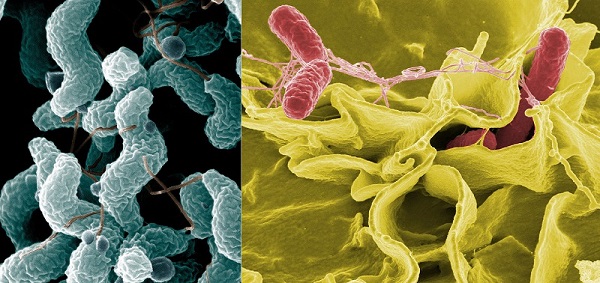Many different disease-causing germs can contaminate foods, so there are many different foodborne infections. The US CDC estimates that each year 48 million people get sick from a foodborne illness, 128,000 are hospitalized, and 3,000 die. Researchers have identified more than 250 foodborne diseases. Most of them are infections, caused by a variety of bacteria, viruses, and parasites. Harmful toxins and chemicals also can contaminate foods and cause foodborne illness.
Food Poisoning
Although anyone can get a foodborne illness, some people are more likely to develop one. Those groups include Pregnant women, Young children, Older adults, People with immune systems weakened from medical conditions, such as diabetes, liver disease, kidney disease, organ transplants, HIV/AIDS, or from receiving chemotherapy or radiation treatment. Most people with a foodborne illness get better without medical treatment, but people with severe symptoms should see their doctor.
FOOD POISONING SYMPTOMS
Common symptoms of foodborne diseases are nausea, vomiting, stomach cramps, and diarrhea. However, symptoms may differ among the different types of foodborne diseases. Symptoms can sometimes be severe and some foodborne illnesses can even be life-threatening. Most people have only mild illnesses, lasting a few hours to several days. However, some people need to be hospitalized, and some illnesses result in long-term health problems or even death. Infections transmitted by food can result in chronic arthritis, brain and nerve damage, and hemolytic uremic syndrome (HUS), which causes kidney failure.
Food poisoning symptoms may range from mild to severe and may differ depending on the germ you swallowed (see Table 11.3.111.3.1below). After you consume a contaminated food or drink, it may take hours or days before you develop symptoms. See your doctor or healthcare provider if you have symptoms that are severe, including:
- High fever (temperature over 101.5°F, measured orally)
- Blood in stools
- Frequent vomiting that prevents keeping liquids down (which can lead to dehydration)
- Signs of dehydration, including a marked decrease in urination, a very dry mouth and throat, or feeling dizzy when standing up.
- Diarrhea that lasts more than 3 days
The top five germs that cause illnesses from food eaten in the United States are Norovirus, Salmonella, Clostridium perfringens, Campylobacter, and Staphylococcus aureus (Staph).

Figure 11.3.1: (left) Campylobacter, a bacteria that is a major cause of food poisoning and (right) Salmonella. Images used with permission (Public Domain; De Wood, Pooley, USDA (left) and Rocky Mountain Laboratories, NIAID, NIH).
Some other germs don’t cause as many illnesses, but when they do, the illnesses are more likely to lead to hospitalization. Those germs include Clostridium botulinum (botulism), Listeria, Escherichia coli (E. coli), and Vibrio.
| Germ and Typical Time for Symptoms to Appear | Typical Signs and Symptoms | Common Food Sources |
|---|---|---|
| Campylobacter 2 – 5 days |
Diarrhea (often bloody), stomach cramps/pain, fever | Raw or undercooked poultry, raw (unpasteurized) milk, and contaminated water |
| Clostridium botulinum 18 – 36 hours |
Double or blurred vision, drooping eyelids, slurred speech. Difficulty swallowing, breathing and dry mouth. Muscle weakness and paralysis. Symptoms start in the head and move down as severity increases | Improperly canned or fermented foods, usually homemade. Prison-made illicit alcohol. |
| Clostridium perfringens 6 – 24 hours |
Diarrhea, stomach cramps. Vomiting and fever are uncommon. Usually begins suddenly and lasts for less than 24 hours | Beef or poultry, especially large roasts; gravies; dried or precooked foods |
| Cyclospora 1 week |
Watery diarrhea, loss of appetite and weight loss. Stomach cramps/pain, bloating, increased gas, nausea, and fatigue. | Raw fruits or vegetables, and herbs |
| Escherichia coli 3 – 4 days |
Severe stomach cramps, diarrhea (often bloody), and vomiting. Around 5-10% of people diagnosed with this infection develop a life-threatening complication. | Raw or undercooked ground beef, raw (unpasteurized) milk and juice, raw vegetables (such as lettuce), and raw sprouts, contaminated water |
| Listeria 1 – 4 weeks |
Pregnant women typically experience fever and other flu-like symptoms, such as fatigue and muscle aches. Infections during pregnancy can lead to serious illness or even death in newborns. Other people (most often older adults): headache, stiff neck, confusion, loss of balance and convulsions in addition to fever and muscle aches. |
Raw (unpasteurized) milk, soft cheeses made with raw milk, raw sprouts, melons, hot dogs, pâtés, lunch meats, and cold cuts, smoked seafood |
| Norovirus 12 – 48 hours |
Diarrhea, nausea/stomach pain, vomiting | Infected person, contaminated food like leafy greens, fresh fruits, shellfish (such as oysters), or water, or by touching contaminated surfaces |
| Salmonella 12 – 72 hours |
Diarrhea, fever, stomach cramps, vomiting | Eggs, raw or undercooked poultry or meat, unpasteurized milk or juice, cheese, raw fruits and vegetables |
| Staphylococcus aureus (Staph) 30 minutes – 6 hours |
Diarrhea, nausea, stomach cramps, vomiting | Foods that are handled by people and not cooked (sliced meat, puddings, pastries, and sandwiches). Raw (unpasteurized) milk and cheese made from it. |
| Vibrio 1 – 4 days |
Watery diarrhea, nausea. stomach cramps, vomiting, fever, chills | Raw or undercooked shellfish, particularly oysters |
Contributors
- US Center for Disease Control
Candela Citations
- Food-Borne Illness. Authored by: Medical LibreTexts Contributors. Provided by: LibreTexts. Located at: https://med.libretexts.org/Courses/Sacramento_City_College/SCC%3A_Nutri_300_(Coppola)/Chapters/11%3A_Food_Safety_Concerns_and_Future_of_our_Food/11.3%3A_Food-Borne_Illness. License: CC BY-NC-SA: Attribution-NonCommercial-ShareAlike
